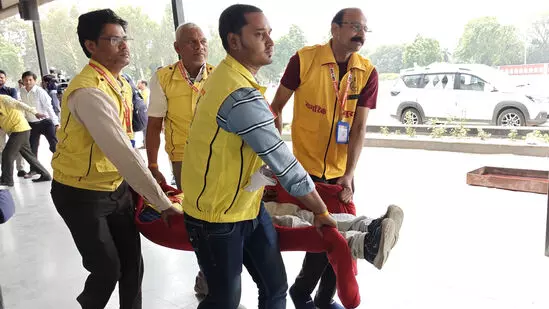Begin typing your search above and press return to search.
Nationwide Civil Defence Mock Drills Begin at 4 PM Today: Key Guidelines and Top 10 Updates

In a landmark move to test the country’s readiness for emergency situations like air raids and blackouts, the Ministry of Home Affairs (MHA) has launched a massive nationwide civil defence mock drill on Wednesday, May 7 — the first such comprehensive exercise in decades. The timing is significant: the drill comes just hours after India carried out precision airstrikes targeting terror camps in Pakistan and Pakistan-Occupied Kashmir (PoK), in response to the April 22 terror attack in Pahalgam that killed 26 people.
What’s Happening and Why
The mock drill — held in 244 districts across the country — is designed to simulate real-time hostile scenarios such as aerial bombings, mass evacuations, fires, and blackouts. These drills aim to strengthen civilian preparedness and improve coordination between government departments and response forces.
According to officials, the exercise is not only a show of defensive readiness but a proactive training effort under the Civil Defence Act of 1968. The first drills began at 4 PM today across various states and Union Territories.
The drills include sounding air raid sirens, switching off lights to simulate blackouts, training civilians in sheltering and first aid, updating evacuation plans, and practicing camouflage measures for key installations.
Government’s Message: Prepared, Not Provocative
India’s official statement on its recent military operation described the airstrikes as a “precise and restrained” response to terror threats, emphasizing that no civilian, economic or military targets were hit. This calculated move, officials say, is in line with India’s broader passive defence strategy — where civil preparedness plays a central role.
Key Drill Highlights from Across India
• Delhi: Operation Abhyaas is underway at 55 locations across the capital. Schools have been instructed to train students and play demonstration videos.
• Maharashtra: Over 10,000 civil defence and NCC volunteers are involved. Drills are taking place across Mumbai, Pune, Thane, Ratnagiri, and more.
• Karnataka: Bengaluru, Karwar, and Raichur are conducting drills due to the “new and complex threats” emerging post-Pahalgam attack.
• Uttar Pradesh: Full-scale rehearsals, including simulated bomb blasts, are happening across major districts like Lucknow, Varanasi, and Jhansi. Bareilly will observe a blackout from 8 PM to 8:10 PM.
• Gujarat: Drills at 18 districts, followed by a voluntary blackout between 7:30 PM and 8 PM.
• Kerala, Assam, Rajasthan, Andhra Pradesh, and others: Also conducting extensive drills involving local officials, students, and volunteers.
What Are These Drills Preparing Us For?
The drills test readiness for:
• Air raids
• Sudden blackouts (crash blackout procedures)
• Mass evacuation scenarios
• Coordinated emergency response
Citizens are being trained to identify air raid sirens, locate nearby shelters, simulate blackout conditions at home, and also to report suspicious activities,if any.
What You Should Do and Avoid During a Mock Drill
DOs:
• Recognize siren signals (long wails = alert, short bursts = all-clear)
• Know your nearest shelter
• Keep emergency kits (torches, water, medicine)
• Switch off all lights
• Include children and elders in the drill
• Participate in school and community training
DON’Ts:
• Avoid using mobile phones during drills
• Don’t leave lights on during blackouts
• Don’t share sensitive information or drill photos on social media
• Don’t panic or ignore instructions from authorities
State-Wise Tally of Civil Defence Mock Drill Categories
The MHA has classified districts under three civil defence categories based on vulnerability and strategic importance.
Category-I (High Importance):
These are major urban centers, industrial zones, border districts, or places with critical infrastructure.
• States/UTs with Category-I districts only:
• Delhi, Kerala, Goa, Lakshadweep, Puducherry, Sikkim, Tamil Nadu, Telangana, Tripura, Uttarakhand
• Larger states with many Category-I districts:
• Maharashtra, Uttar Pradesh, West Bengal, Punjab, Rajasthan, Gujarat, Jammu & Kashmir, Assam, Odisha
Category-II (Moderate Importance):
Include backup strategic locations or vulnerable secondary districts.
• Examples:
• Bhusawal, Ratnagiri, Dangs (Gujarat), Bareilly (UP), Godda (Jharkhand), Bhadrak (Odisha)
Category-III (Lower Threat/Remote Areas):
• Fewer in number. Mostly remote hilly areas with strategic but less dense populations.
• Examples:
• Bomdila (Arunachal Pradesh)
Sample of Participating Cities by State:
• Delhi: Entire territory (Category-I)
• Maharashtra: Mumbai, Pune, Thane, Aurangabad, etc.
• Karnataka: Bengaluru, Raichur
• Uttar Pradesh: Lucknow, Varanasi, Bareilly, Jhansi
• Gujarat: Ahmedabad, Surat, Vadodara, Kutch, Mehsana
• Assam: Guwahati, Dibrugarh, Tinsukia
• J&K: Srinagar, Jammu, Anantnag, Kargil, Leh
• West Bengal: Kolkata, Siliguri, Durgapur, Darjeeling
• Odisha: Bhubaneswar, Rourkela, Paradip
This civilian-first approach is a reminder that national defence is not just the military’s responsibility — it’s a collective one. As India’s geopolitical environment becomes more complex, This extensive exercise marks a pivotal moment in India’s civil preparedness strategy.
Next Story
